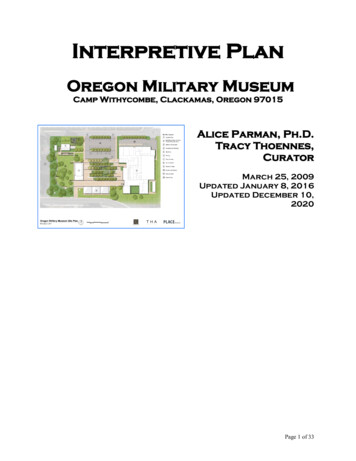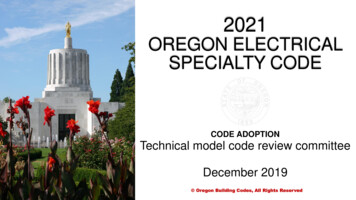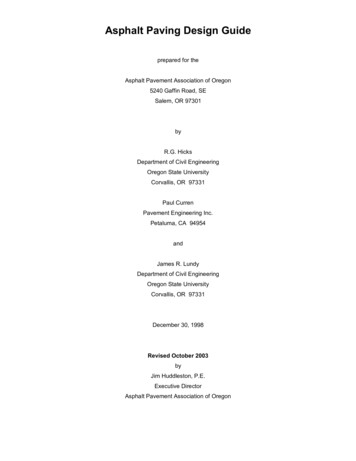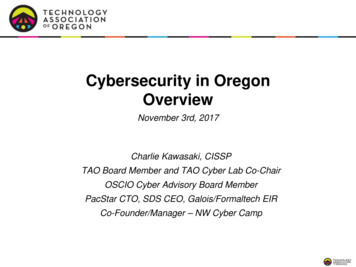
Transcription
Interpretive PlanOregon Military MuseumCamp Withycombe, Clackamas, Oregon 97015Alice Parman, Ph.D.Tracy Thoennes,CuratorMarch 25, 2009Updated January 8, 2016Updated December 10,2020Page 1 of 33
TABLE OF CONTENTSINTRODUCTIONNew DirectionsMission and GoalsGuiding Principles of Interpretation at the Oregon Military MuseumAudience Development and Institutional Identity4SITE OVERVIEWThree Main Thematic Elements The Central Plaza The Historic Park The Main Building7MAIN BUILDING SELF-GUIDED THEMED GALLERIES OVERVIEWMain Exhibit HallTemporary, Changing Theme GalleriesWeapons CollectionHall of Valor8THE VISITOR EXPERIENCE AT THE OREGON MILITARY MUSEUMArrival and Entry10SELF-GUIDED THEMED GALLERIESMain Exhibit Hall, Permanent Exhibition: Serving Oregon Serving Our CountryOur Roots: From Citizen Warriors and Militiamen to the ORNGCitizen WarriorsThe Oregon Militia and the Birth of the Oregon National GuardReady! Aim! Fire!Keeping the PeaceFirst Overseas Service: The Spanish-American War / Philippine InsurrectionAt War on Two OceansBattle-TestedAmong Our SouvenirsInterlude: Between the Spanish-American War and World War IThe Road to BataanAbove and BeyondFire and FloodCitizen Sailors: The Oregon Naval Militia, 1898-1916Doughboys: Mexican Border Service and World War I, 1916-1918Guarding the BorderOver ThereInterlude: The Inter-War YearsThe Treaty of Versailles and its AftermathHome Front DutyA World at War: World War II, 1939-1945Mobilizing for War11Page 2 of 33
War in the PacificOregon on a War FootingContinuous Combat: the TimberwolvesOregonians Take to the SkiesBreaking BarriersExceptional ValorInterlude: the Postwar PeriodCold War AheadVisitor Rest & Relaxation AreaThe Cold War, 1945-1989At War in Asia: The Korean War, 1950-1953Grunts and Guardsmen: The Vietnam War, 1959-1975Advisors and PeacekeepersIn Our Time: 1990s to the Present DayThe Gulf War: Operation Desert Shield and OperationDesert Storm, 1990-1991Global War on Terrorism, 2001–Patrolling the Skies: the 142nd Fighter WingService at Home and Around the WorldBreaking BarriersAbove and BeyondHomeland SecurityWe Are FamilyMail CallTaking Care of Our OwnRememberThe Guard TodayWhere in the World is the ORNG?A Day in the LifeDo Your Best, Give Your BestServing State and NationTest Your ORNG IQOpportunitiesTemporary, Changing Theme GalleriesThe Weapons CollectionThe Hall of ValorOTHER INTERPRETIVE FEATURES ON THE GROUNDSHistoric ParkCamp Withycombe and the Clackamas Rifle RangeQuartermaster StorehouseBattery A Field Artillery Horse BarnHonor GardenTrack and Treads Vehicle PavilionWorld War II Quonset Hut30TOTAL SQUARE FOOTAGE OF INTERPRETIVE SPACE33Page 3 of 33
INTRODUCTIONNew DirectionsFounded in 1975, the Oregon Military Museum (OMM) has built unique collections thatdocument the role of the Oregon National Guard and Oregonians' military service andcontributions to state, national, and world history. Through the years, the Museum haswelcomed Soldiers and Airmen, Sailors and Marines, veterans, and their families, along withcommunity members and travelers, to view the exhibits and share their stories. Researcherscome from all over the country to study the collections and work in the archives. Dedicatedvolunteers spend countless hours restoring historic military vehicles and sharing them withOregonians at parades, commemorations, and other community events. Living History Day atCamp Withycombe, home of the Oregon Military Museum, has drawn enthusiastic crowds totake part in hands-on family activities that interpret Oregon's military heritage.The Department of Defense’s base realignment and closure (BRAC) process at CampWithycombe presented the Oregon Military Museum with a unique opportunity to expand anddeepen its interpretive scope. In 2009, the Museum's collections and operations were moved tothe 1954 Clackamas Armory, an outdated building requiring remodeling and reconfiguring. Anew Historic Area was established, encompassing the decommissioned Armory, the NationalRegister-eligible circa 1911 field artillery horse barn, the circa 1911 Quartermaster Storehouse,and a World War II Quonset hut.These opportunities have enabled the Oregon Military Museum to become a venue for highquality visitor experiences, commensurate with OMM's nationally significant collection. Weinvite all friends of Oregon military history, including all veterans, to join with us in making thisvision a reality.Initially in 2009, the Oregon National Guard (ORNG) commissioned Architects Barrentine BatesLee AIA (BBL) to develop an architectural master plan, in collaboration with landscapearchitecture firm Walker Macy. The architectural master plan defined the scope and content ofdesign and construction to transform the Clackamas Armory and its grounds into the new homeof the Oregon Military Museum.By 2013, the architectural team had evolved to include full time personnel from the OregonMilitary Department’s Installations Division, award-winning design architect Don Stastny, THAArchitecture (now Hacker), and PLACE studio, along with contractors Precision ConstructionCompany and numerous engineering firms. The newest architectural plan further refined thescope and content of the project, adding many new and innovative features that will make ourvision for the site and facilities a reality.The creation of visitor experiences for this state-of-the-art facility and site, including associatedhistoric structures and outdoor interpretive features, will be guided by this interpretive masterplan. Working closely with Museum Curator Tracy Thoennes and the Museum's exhibitcommittee, Alice Parman, Ph.D. authored the original draft plan. After careful review byMuseum professionals, scholars, and Oregon National Guard officers and staff, Parman prepareda final interpretive master plan. Thoennes and the exhibit committee further revised the plan inPage 4 of 33
2015 and 2016, to reflect additions and changes to the site, additional proposed exhibits, theMuseum’s name, and a revised Museum mission statement.These architectural and interpretive master plans guide subsequent planning, design, andconstruction of the Museum's buildings and grounds. They are also invaluable communicationsand fundraising tools during the Museum’s capital campaign.Mission and GoalsTo ensure that new exhibits and programs convey the unique identity and values of the OregonMilitary Museum, the interpretive plan is firmly grounded in the Museum's mission:The Oregon Military Museum was established in 1975 by the Oregon Military Department as thestate's official military repository. Its mission is: To inspire and educate visitors about Oregon's military heritage and legacy to include theNational Guard, the state's early militia, and all branches of the Armed Forces. To meet its professional stewardship obligations for the historical artifacts and archivesentrusted to its care.The Goals of InterpretationAccording to Freeman Tilden, author of Interpreting Our Heritage, the aim of interpretation is“to reveal meanings and relationships rather than simply to communicate factual information.”Interpretation provokes attention and curiosity, relates concepts and facts to visitors’ own lives,and reveals key messages in unforgettable ways. Making use of a variety of objects,experiences, and media, interpretive exhibits and programs appeal to as many senses as possible.Interpretive displays and activities seek to engage visitors intellectually, emotionally, andphysically.Take-Home Messages and Interpretive GoalsGuided by the Museum's mission, the first step in interpretive planning is to determine the bigideas to be conveyed to all visitors. Working with interpretive planner Alice Parman, theMuseum's staff, stakeholders, and key members of the Oregon National Guard have identifiedfive core take-home messages: The military is an enduring part of Oregon's past, present, and future. Military service members are my neighbors and co-workers; they have volunteered forextra responsibility. Working together with respect, people can accomplish amazing things. History is interesting, important, and relevant. I am part of history.Take-home messages provide the conceptual framework for organizing the visitor’s experienceof the Oregon Military Museum. Interpretive goals describe how these visitor experiences areintended to influence visitors’ understanding, attitudes, and behavior. We expect that during andafter their visit, many visitors will: Feel new or renewed respect for values associated with military service: duty, honor,service, endurance, and valor; Understand the meaning of "freedom isn't free";Page 5 of 33
Express a personal connection to the past, including their own family history; Share their excitement about the Museum with friends and family, and make plans forfrequent repeat visits.Guiding Principles of Interpretation at the Oregon Military MuseumCitizen Soldiers, Airmen, Sailors, and Marines are the stars of this exhibit.Personal stories bring images and artifacts to life. First-person accounts bear witness to the quietheroism and devotion to duty made by the thousands of Oregonians who have served in themilitary. This testimony also conveys the camaraderie and tradition of military service. Visitorsin turn will be inspired to share their stories.Visitors view Oregon's history through the lens of military experience.The military is revealed as a unique cultural institution with a proud history, tradition, andidentity––expressed in uniform styles and colors, insignia, and weaponry through time. Visitorsdiscover connections between military traditions and Oregon's history and popular culture. Asthey follow Oregonians to humanitarian missions and wartime duties throughout the nation andthe world, visitors begin to think of Oregon history in national and world context. They becomeaware of historic military sites and resources, in Oregon and elsewhere, featured in OMMdisplays.The Museum interprets Oregon military history as lived by participants, and understood today.Visitors get a sense of what it has meant to go to war in different eras; they see how the nature ofcombat has changed because of technological innovation and conditions on the ground.Firsthand accounts express how military service members from all branches fight, cope, learnfrom experience, and keep working to make a difference. The distinct roles of the NationalGuard on the home front are a revelation to many visitors: the Guard's unique responsibility tomaintain civil order, and its participation in humanitarian, firefighting, and rescue missions.People of all backgrounds relate to the experiences of family members: life on the home front,deployment and re-integration, casualties of war, and how families and communities supportservice men and women.A chronological pathway unfolds a fascinating story, rich in authentic objects and images, withunique opportunities to study, look closely, and even touch the past.Each time period has at least one centerpiece, ranging from a single artifact or photograph to afull-scale diorama. Whatever the scale, the focal piece is dramatically lit, drawing visitors in.Stage-set decor and graphic motifs reinforce the look and feel of each historic period. Headlinesand quotes also play a role, with cultural references and dates to place visitors chronologically.When visitors choose to move randomly among time periods, they remain aware that a story isunfolding within the exhibit space.Audience Development and Institutional IdentityThrough exhibits, special events, and volunteer programs in its previous location, the OregonMilitary Museum reached an average of 4,000 visitors per year. Most have been veterans, andfamily members of veterans.In the past, security and manpower issues forced the Museum to set strict limits on attendance.Because the Museum's exhibits displayed priceless artifacts in unprotected touch zones, visitorsPage 6 of 33
could only tour the galleries under close supervision. An important goal for the new facility is tohouse all original objects securely and safely. This will enable the Museum to expand publichours and welcome many more visitors. These additional security and staffing resources willallow OMM to engage all of Oregon’s service members, veterans, and their families, andincrease additional target audiences of school and youth groups, non-military families, tourists,veterans' associations, and general visitors of all ages and backgrounds.The desire to build and diversify the Museum’s audience has influenced many of the visitorexperiences proposed in this document. By presenting storylines, collections, and educationalopportunities in personal and highly accessible ways, the Museum’s exhibits can appeal to amulti-age audience, including families and school groups.OMM displays will also create new opportunities for in-depth exploration. This potential will bebest fulfilled by increasing staff capacity to present customized tours to special interest groups,and to recruit, train, and supervise volunteer guides. The exhibits proposed in this plan are selfguided with the exception of the Battery A Field Artillery Horse Barn and the World War IIQuonset hut; but visitors’ experience will be even more memorable when they can personallyinteract with knowledgeable museum resource people.Through exhibits that intrigue, engage, and educate, we will offer rewarding experiences for allvisitors. By building changeability and flexibility into exhibit design, the Oregon MilitaryMuseum will become a leading regional attraction, with ongoing repeat visitation by nearbyresidents and tourists alike. And by serving as a gateway to introduce visitors to military historysites and resources throughout the state, OMM will play a key role in Oregon's museum andcultural communities.SITE OVERVIEWThe Oregon Military Museum is experiencing institution-wide renewal. New exhibits in theremodeled Clackamas Armory and the 4-acre site will reflect an expanded, deepenedinterpretation of Oregonians’ military service and the Oregon National Guard. The Museum’snationally significant collection will be the focus of engaging, in-depth exhibits for amultigenerational audience. All friends of Oregon’s military history are invited to be part ofrealizing the vision outlined here.Approaching and entering the grounds of the Oregon Military Museum, visitors encounter threemain thematic elements that set the stage for a memorable visit: the Central Plaza, the HistoricPark, and the Main Building. Guided by appropriate signage, visitors can explore the entireMuseum grounds. During Living History Day and other special events, when re-enactors andlive interpreters are present, these educational resources truly come to life.Three Main Thematic Elements The Central Plaza contains visitor drop off and parking zones, and provides the first view ofthe museum grounds. The large, open grassy area provides ample space for outdoor eventuse, such as military parade grounds and living history interpreters’ reenactments andmilitary encampments. The area might also include a small Honor Garden recognizingOregon’s veterans of all wars. Beyond the parade grounds is the Tracks and Treads vehiclepavilion that interprets large scale macro artifacts in a weather-protective setting.Page 7 of 33
The Historic Park is to the right (west) as visitors enter. The Park encompasses a pastoralsetting of very large, old trees and two circa 1911 historical buildings: the Battery A FieldArtillery Horse Barn and the Quartermaster Storehouse. These structures were rescued fromdemolition and relocated here in order to interpret the history of Camp Withycombe, aformer military encampment site and a target range. Additionally, the “Walk of Honor”engraved brick pathway might be placed here, set among the old growth trees within thepark-like setting, inviting visitors to investigate further and take time to reflect. The Main Building of the Oregon Military Museum is to the left (east) of the CentralPlaza. Visitors enter the Lobby, and find the Museum Store and other welcoming visitorservices. Founders’ and major supporters’ plaques salute the generous contributors whosefarsighted vision made the new Museum a reality. The journey through military historybegins in depth from here, through self-guided galleries of the Main Exhibit Hall, TemporaryExhibits Galleries, the Weapons Collection, and the Hall of Valor.MAIN BUILDING SELF-GUIDED THEMED GALLERIES OVERVIEWMain Exhibit Hall - Serving Oregon Serving Our CountryFollowing a dynamic overview of military service, visitors embark on a journey through timeand enter a space that is rich in history. Lighting and signage lead them along a chronologicalpathway. Visual clues point ahead to areas that may be of special interest to some visitors. Thestory unfolds through several centuries, and many generations. The journey of discovery beginswith the legacy of many generations of Oregon's Native peoples: since time immemorial, theywere the original citizen warriors of Oregon.Our Roots documents Oregon’s earliest military history, from Native American citizen warriortraditions, through Lewis and Clark’s first U.S. military venture into the Pacific Northwest, to theorganization of Oregon’s earliest militia. Visitors learn about Oregonians’ involvement in theCivil War, and follow the course of protracted Indian Wars, with Native warriors involved onboth sides. Historic photos and documents, and a few precious artifacts, attest to the central roleof military effort in establishing Oregon as a territory and a state, culminating in 1887 legislationestablishing the Oregon National Guard. The finale of Our Roots is an electronic shootinggallery where visitors can safely handle replicas of 19th century weapons.First Overseas Service details the campaigns of the Spanish-American War and the PhilippineInsurrection, 1898-1899. A tropical look and feel, a magic lantern show, and original artifactsimmerse visitors to headline news and rapidly unfolding events that led Oregonians to fightoverseas for the first time. Souvenirs and personal memoirs provide evidence of the decisiverole played in the Philippines by the 2nd Oregon U.S. Volunteer Infantry.Here as throughout the timeline, special features and interludes portray the peacetimeresponsibilities and accomplishments of Oregonians in military service. In the period beforeWorld War I, the Oregon Naval Militia and the Coast Artillery Corps are in the spotlight.Doughboys puts Camp Withycombe in the center of Oregon’s response to incursions into U.S.territory by Mexican revolutionary Pancho Villa. In Guarding the Border, period images andPage 8 of 33
artifacts bring Soldiers’ memories of Mexican Border Service to life. Visitors gain appreciationfor this nationwide call-up as a training exercise that prepared the United States military forservice in World War I. The centerpiece of Over There is a fully restored Liberty Truck.Uniformed mannequins represent an infantryman, a bilingual telephone operator, and aballoonist. Supported by artifact and photo collections as well as first-person accounts, thesedisplays put both women and men in touch with the “war to end all wars” from three verydifferent perspectives.A World at War is the Museum’s largest display, reflecting the depth and breadth of its WorldWar II collections. Mobilizing for War honors shipyard workers whose contributions werecritical to victory in both the European and the Pacific theaters. Opening toolboxes and lunchpails, visitors find photos and memories of men and women throughout Oregon who contributedto the war effort. A photo essay with artifacts documents coastal defense units, and a Japaneseattack on Fort Stevens. War in the Pacific begins with headlines and maps detailing anembattled nation, mourning Soldiers stranded in the Philippines and men and ships lost duringPearl Harbor. A centerpiece diorama of a destroyed Japanese HaGo tank invites visitors tofollow the path of the Sunset Division Jungleers; authentic images and artifacts and aninteractive game bring their island-hopping amphibious attacks to life.Oregon on a War Footing showcases fascinating artifacts and photos to convey the involvementof ordinary men, women, and children in the war effort. Vintage calendar pages trace theContinuous Combat of the 104th Infantry Division Timberwolves during the 195 days that tookthem from Cherbourg to the Elbe River. Visitors use binoculars and stereoscopic viewers tolearn about the air war in Oregonians Take to the Skies. Breaking Barriers pays tribute towomen and members of minority groups who overcame discriminatory laws to serve theircountry. Exceptional Valor honors all of Oregon’s Medal of Honor recipients, with a specialfocus on the selfless actions of 2nd Lt. David R. Kingsley, for whom the 173rd Fighter Wing’sKingsley Field is named.Before continuing along the timeline, visitors can relax and browse in the Rest & RelaxationArea. Comfortable benches are also available at strategic locations throughout the exhibitgalleries.The Cold War documents the period from 1945 to 1989: the Korean War, the Vietnam War era,and European conflicts through the demise of the Soviet Union. Centerpiece exhibits of the F-86Sabre Jet as well as vehicles, photos, memorabilia, and quotes from oral histories show the rolesplayed by Oregonians, both overseas and stateside, during these historic events.In Our Time continues the story of Oregon’s military history through the present day. Anartifact-rich feature on the Gulf War is followed by a chronology and changeable updates on theGlobal War on Terrorism since 2001. A special feature honors the role of the 142nd FighterWing, Patrolling the Skies over the West Coast. The timeline culminates in a web-basedinteractive experience, Homeland Security, where visitors are immersed in the ORNG’s unifiedemergency management and response system. They take roles, make decisions, and find out theconsequences of those choices.Page 9 of 33
We Are Family, changeable (and very personal) exhibits by and for veterans and their families,reflects the daily lives of people who most unfailingly support their deployed loved ones. Amemorial quilt, first-person stories, and excerpts from a theater piece written and performed byveterans are highlights of this special display.The Guard Today offers a lively introduction to the challenging, rewarding daily lives ofcitizen Soldiers and Airmen. In Where in the World is the Oregon National Guard?, visitorslearn about key roles of the National Guard and see where the ONG has been deployed, such asTask Force Phoenix V. A Day in the Life pairs mini-biographies with hands-on experiences, asvisitors follow recruits through their first day of training. An obstacle course, Do Your Best,Give Your Best, lets adults and children measure their abilities against the Guard’s fitnessstandards. The ORNG’s humanitarian and civil defense activities are documented in ServingState and Nation, to include deployments for Hurricane Katrina and wildfire fighting. Visitorsassess their knowledge of military etiquette and tradition in Test Your ORNG IQ, and use atouch-screen computer to learn more about Opportunities offered by the Oregon National Guard.Temporary, Changing Theme GalleriesCreated to be flexible with rotating exhibits, these galleries are designed to inspire returnvisitation and complimenting educational programming, as well as to forge partnerships withother cultural and community organizations. Examples of exhibitions might include: NotableFigures in Oregon’s Military History, Walk a Mile in These Shoes, Aspects of Insignia, OregonPainters of Military Themes, Oregonians who were Prisoners of War, Letters Home.The Weapons CollectionThe Weapons Orientation and Weapons Rooms encompass state-of-the-art displays for theMuseum’s outstanding small arms and artillery collections, inviting visitors to preview collectionhighlights and view many of these rare artifacts in a display format that meets the securityrequirements for weapons. Interpretive displays along a reader rail offer fascinating facts fornovices, and enough technical information to satisfy military history buffs.Hall of ValorThe Hall recognizes acts of valor and great courage in the face of danger performed by Oregon’sSoldiers, Sailors, Airmen and Marines. It can also serve as a gathering place, small classroom,meeting room, or tour orientation room.THE VISITOR EXPERIENCE AT THE OREGON MILITARY MUSEUMThe exhibit ideas described below represent a conceptual framework for exhibit design.Typically, more ideas are offered than can be accommodated in the available space andadditional ideas emerge during the design phase. Therefore this narrative description should beread as an approach or concept, a vision that will guide designers, the architect, fundraisers, andothers who will work together to make the new Oregon Military Museum a reality.Arrival and EntryAs visitors approach the Oregon Military Museum, attractive signage directs them to the entry.Along a wrought-iron style fence, decorative elements based on uniform colors and camouflagedesigns might be used to create a sense of history.Page 10 of 33
Entering the grounds and proceeding to the parking lot, visitors notice macro artifacts, historicstructures in a park-like setting of old growth trees, and make a note to tour them later.Interpretive graphic panels throughout the site orient visitors to elements within the museumgrounds and introduce them to Camp Withycombe’s history. Other interpretive elements couldinclude an interactive sandbag filling station celebrating the Oregon National Guard's invaluablehumanitarian service in their home state and throughout the nation.In the Lobby, a friendly greeter welcomes visitors and invites them to sign in. An attractivebrochure includes a floor plan, and information about membership, donation, and sponsorshipopportunities. A changeable signboard shows upcoming events and volunteer openings.Appealing window displays preview the Museum store, stocked with unique merchandise. Onthe wall to the left of the restrooms, a founders' plaque pays tribute to contributors who havemade the new building possible, and whose continuing support ensures its success.SELF-GUIDED THEMED GALLERIESFour main exhibition areas within the main Museum building are: the Main Exhibit Hall,Changing Theme Gallery, the Weapons Collection, and the Hall of Valor.Main Exhibit Hall – Permanent Exhibit: Serving Oregon Serving Our CountryFrom the Lobby, visitors can see the entryway to the Museum's main exhibit gallery.Moving through the doorway, visitors enter the 9,000-square-foot former drill floor of theClackamas Armory. Here they encounter an engaging and memorable exhibit, Serving Oregon Serving Our Country. Through the magic of exhibit design, the drill floor is transformed into ajourney that takes visitors all over Oregon, and throughout the world. Yet the shape and textureof the armory can still be seen. Visitors are aware of being in a spacious, solidly constructedbuilding where generations of men and women have trained and prepared to serve.Entering the main exhibit hall, visitors begin their journey with Our Roots, the first exhibit in thehistory timeline. As visitors travel through time, they encounter compelling authentic objects,richly evocative images, dramatic vignettes and dioramas, media presentations, and a wealth offirst-hand quotes. The combined effect brings history to life. The look and feel of casework andgraphics, within a defined range of materials and typefaces, reinforce visitors' sense of being ineach specific time and place. Securely and safely protecting valuable (and potentiallydangerous) artifacts from harm, exhibit components allow visitors to look closely, and (whereappropriate) interact with replicas, and even with carefully selected original objects.Our Roots:From Citizen Warriors and Militiamen to the Oregon National GuardCitizen WarriorsIt is envisioned that this exhibit will be developed in collaboration with designatedrepresentatives of Oregon Tribes. The description below is a “what if” that could serve as astarting point for those discussions.A title panel is displayed on a replica tule mat, framed in cedar. Suspended from the ceiling,beautifully lit banners display portraits of American Indian men and women of the OregonPage 11 of 33
Country, whose lives became entwined with those of Euro-American newcomers in the 19thcentury. Interpretive panels with firsthand quotes give visitors a sense of the difficult choicesfaced by Native people during this period. Contemporary images and quotes honor AmericanIndian veterans of recent decades. Beaded items, loaned by Native artists and tribal museums,trace the service and sacrifice of American Indian veterans through many generations.Beneath the banners, framed period images portray individuals and families caught up inconflicts––and efforts to keep the peace––as ancestral lands were taken over by forts, militaryroads, and homesteads, defended in turn by citizen militias and Indian scouts. Mini-biographies,and a few precious artifacts, personalize a timeline that weaves together the military history ofthe Oregon Country with stories of settlement, commerce, territory, manifest destiny, andstatehood.The Oregon MilitiaThe timeline continues with Captains Meriwether Lewis and William Clark and PresidentJefferson's Corps of Volunteers for North Western Discovery, the first U.S. military venture intothe Pacific Northwest. Historic paintings and re-enactment photos depict key encounters inOregon, the unique role played by Sacagawea and her son, and the construction of Fort Clatsop.(A sidebar shows ORNG members helping to rebuild the fort after a devastating fire in 2005.) Avintage mural reproduction depicts the "Wolf Meeting" that led to organization of Oregon'searliest militia. Mini-biogr
Mar 25, 2009 · Living History Day at Camp Withycombe, home of the Oregon Military Museum, has drawn enthusiastic crowds to take part in hands-on family activities that interpret Oregon's military heritage. The Department of Defense’s base realignment and closure (BRAC) process at










